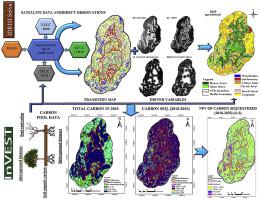Journal of Cleaner Production ( IF 11.1 ) Pub Date : 2020-08-05 , DOI: 10.1016/j.jclepro.2020.123333 Deepakshi Babbar , G. Areendran , Mehebub Sahana , Kiranmay Sarma , Krishna Raj , Akhil Sivadas

|
Enhancing and conserving carbon pools in vegetation is a major climate change mitigation strategy. The dynamics of carbon in terrestrial ecosystems depend on processes like photosynthesis, respiration, decomposition and combustion, anthropogenic activities like emission of greenhouse gases and climatic variations in rainfall and temperature, and is stored as biomass in different forms. The quantification of biomass is necessary to understand the productivity of forests, carbon sink and source dynamics and recommend ways to aid sequestration through supply side interventions like afforestation and demand side measures that check wood consumption. In this study, carbon sequestration based on the change in total carbon in two different scenarios using Markov chain and InVEST model is evaluated for the years 2000, 2018 and predicted for 2035. The results show that 1.351 Tg carbon has already been lost from 2000 to 2018 in the forest area of Sariska Tiger Reserve and another 0.107 Tg of carbon is expected to be lost in the predicted future, when we compare the land use land cover of the year 2035 with the present scenario. The local communities extract fuelwood by cutting down tree branches illegally, which leads to carbon loss into the atmosphere. The lower release of carbon in 2035 as compared to 2018 is because of forest management practices e.g., plantations done in the range Tehla-Talabberi, Sariska- Ganeshpura, Alwar buffer-Shoydanpura, Talvriksh-Manavaas, Akbarpur-Kalikhol, Ajabgarh-Jatwana. The study shows that the economic value of carbon lost from 2000-2018 is million $ 214.57 and if we see the economic value of the predicted year 2035, carbon sequestration is worth million $ 17.19. Outputs demonstrate the potential for restoration/reforestation and afforestation as the most practical carbon loss mitigation strategy and calls for improved access to cleaner energy sources where the renewable energy industry and government may pitch in.
中文翻译:

利用马尔可夫链和InVEST模型对印度Sariska Tiger保护区的碳固存进行评估和预测
增强和保护植被中的碳库是缓解气候变化的主要策略。陆地生态系统中碳的动态取决于光合作用,呼吸,分解和燃烧等过程,诸如温室气体排放以及降雨和温度的气候变化等人为活动,并以不同形式作为生物质存储。对生物量进行量化对于了解森林的生产力,碳汇和碳源动态,并建议通过供应方干预(例如绿化和检查木材消耗的需求方措施)来帮助固存的方法是必要的。在这项研究中,基于马尔可夫链和InVEST模型在两种不同情况下基于总碳变化的固碳被评估了2000年,2018年和2035年。结果显示,从2000年到2018年,Sariska Tiger保护区森林地区已经损失了1.351 Tg碳,在比较当年的土地使用土地覆盖率时,预计在未来的将来还会损失0.107 Tg的碳目前的情况是2035年。当地社区通过非法砍伐树枝来提取薪柴,这导致向大气中的碳损失。与2018年相比,2035年的碳释放量较低是因为森林管理做法,例如在Tehla-Talabberi,Sariska-Ganeshpura,Alwar buffer-Shoydanpura,Talvriksh-Manavaas,Akbarpur-Kalikhol,Ajabgarh-Jatwana范围内进行的人工林。研究显示,2000-2018年碳损失的经济价值为214.57美元,如果我们看到预测的2035年的经济价值,碳封存价值百万美元$ 17.19。产出显示出恢复/重新造林和植树造林作为最实用的减碳战略的潜力,并呼吁改善可再生能源行业和政府可能介入的清洁能源的获取。



























 京公网安备 11010802027423号
京公网安备 11010802027423号